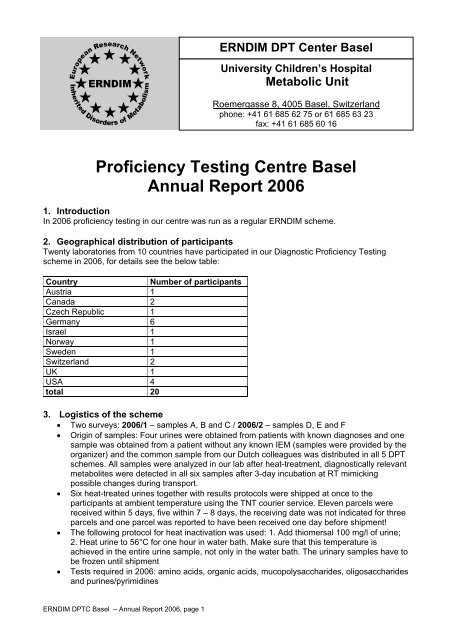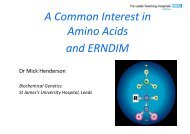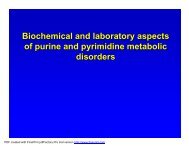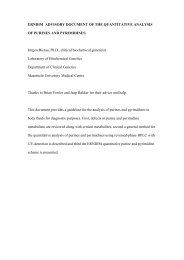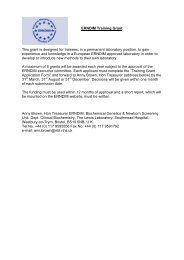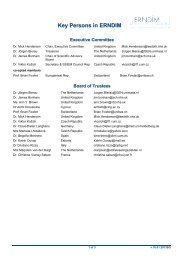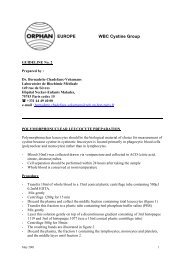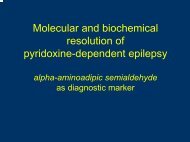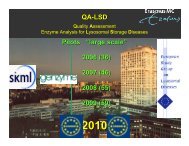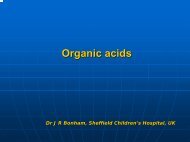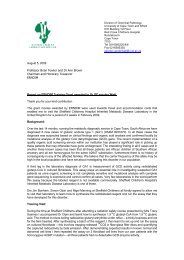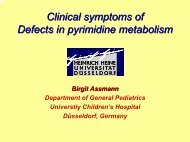DPT Report 2006 - ERNDIM
DPT Report 2006 - ERNDIM
DPT Report 2006 - ERNDIM
Create successful ePaper yourself
Turn your PDF publications into a flip-book with our unique Google optimized e-Paper software.
Proficiency Testing Centre Basel<br />
Annual <strong>Report</strong> <strong>2006</strong><br />
1. Introduction<br />
In <strong>2006</strong> proficiency testing in our centre was run as a regular <strong>ERNDIM</strong> scheme.<br />
2. Geographical distribution of participants<br />
Twenty laboratories from 10 countries have participated in our Diagnostic Proficiency Testing<br />
scheme in <strong>2006</strong>, for details see the below table:<br />
Country Number of participants<br />
Austria 1<br />
Canada 2<br />
Czech Republic 1<br />
Germany 6<br />
Israel 1<br />
Norway 1<br />
Sweden 1<br />
Switzerland 2<br />
UK 1<br />
USA 4<br />
total 20<br />
3. Logistics of the scheme<br />
• Two surveys: <strong>2006</strong>/1 – samples A, B and C / <strong>2006</strong>/2 – samples D, E and F<br />
• Origin of samples: Four urines were obtained from patients with known diagnoses and one<br />
sample was obtained from a patient without any known IEM (samples were provided by the<br />
organizer) and the common sample from our Dutch colleagues was distributed in all 5 <strong>DPT</strong><br />
schemes. All samples were analyzed in our lab after heat-treatment, diagnostically relevant<br />
metabolites were detected in all six samples after 3-day incubation at RT mimicking<br />
possible changes during transport.<br />
• Six heat-treated urines together with results protocols were shipped at once to the<br />
participants at ambient temperature using the TNT courier service. Eleven parcels were<br />
received within 5 days, five within 7 – 8 days, the receiving date was not indicated for three<br />
parcels and one parcel was reported to have been received one day before shipment!<br />
• The following protocol for heat inactivation was used: 1. Add thiomersal 100 mg/l of urine;<br />
2. Heat urine to 56°C for one hour in water bath. Make sure that this temperature is<br />
achieved in the entire urine sample, not only in the water bath. The urinary samples have to<br />
be frozen until shipment<br />
• Tests required in <strong>2006</strong>: amino acids, organic acids, mucopolysaccharides, oligosaccharides<br />
and purines/pyrimidines<br />
<strong>ERNDIM</strong> <strong>DPT</strong>C Basel – Annual <strong>Report</strong> <strong>2006</strong>, page 1<br />
<strong>ERNDIM</strong> <strong>DPT</strong> Center Basel<br />
University Children’s Hospital<br />
Metabolic Unit<br />
Roemergasse 8, 4005 Basel, Switzerland<br />
phone: +41 61 685 62 75 or 61 685 63 23<br />
fax: +41 61 685 60 16
4. Schedule of the scheme in <strong>2006</strong><br />
Sample distribution April 26, Wednesday<br />
Start of analysis of Survey <strong>2006</strong>/1 May 4, Thursday<br />
Survey <strong>2006</strong>/1 – results submission May 24, Wednesday<br />
Survey <strong>2006</strong>/1 – evaluation by organisers (report) June 16, Friday<br />
Start of analysis of Survey <strong>2006</strong>/2 June 26, Monday<br />
Survey <strong>2006</strong>/2 – results submission July 17, Monday<br />
Survey <strong>2006</strong>/2 – evaluation by organisers (report) Sept 1, Friday<br />
Annual meeting of the participants October 5, Thursday<br />
Annual report <strong>2006</strong> December<br />
5. Receipt of samples and results<br />
Date of receipt of samples (samples sent on April 26, <strong>2006</strong>)<br />
Date of receipt<br />
Number of<br />
(reported by participants) participants<br />
1 day 6<br />
2 days 2<br />
5 days 3<br />
6 days 3<br />
7 days 2<br />
not indicated 3<br />
25 April 1<br />
Deadlines of results submission<br />
<strong>2006</strong>/1 <strong>2006</strong>/2<br />
Deadline or before 19 15<br />
8 days delay 1 -<br />
14 days delay - 1<br />
17 days delay - 1<br />
32 days delay - 1<br />
no results 2<br />
6. Scoring system<br />
Analytical performance, interpretative proficiency and recommendations for further investigations<br />
are evaluated. Due to the large variability in reporting results in various countries recommendations<br />
pertaining to treatment are not evaluated in proficiency testing, however, they are still reported and<br />
summarized by the scheme organizers.<br />
A Analytical performance<br />
I<br />
Interpretative proficiency<br />
R Recommendations<br />
<strong>ERNDIM</strong> <strong>DPT</strong>C Basel – Annual <strong>Report</strong> <strong>2006</strong>, page 2<br />
Correct results of the appropriate tests 2<br />
Partially correct or non-standard methods 1<br />
Unsatisfactory or misleading 0<br />
Good (diagnosis was established) 2<br />
Helpful but incomplete 1<br />
Misleading/wrong diagnosis 0<br />
Helpful 1<br />
Unsatisfactory or misleading 0<br />
The total score is calculated as a sum of these three criteria. The maximum that can be achieved<br />
is 5 points per sample, i.e. 15 points per survey and 30 points per year. The scores were<br />
calculated only for laboratories submitting results.
7. Results of samples and evaluation of reporting<br />
Sample A<br />
Patient: The sample was obtained from a 17-year old boy with argininosuccinic aciduria assumed<br />
to be due to argininosuccinate lyase deficiency and cared for in Basel. The diagnosis was based<br />
on examination of urine and plasma amino acids as well as the periodical hyperammonaemia.<br />
Enzymatic or mutational analysis has not been performed but the plasma and urine amino acid<br />
profiles and clinical symptoms leave no doubt as to the diagnosis. The child grew up in Turkey and<br />
came to Switzerland without any diagnosis at the age of 15 years. At that time his general<br />
nutritional state was poor. B12 deficiency was found coincidental to the basic defect.<br />
Analytical performance: 18 Laboratories reported amino acid analyses and 15 were able to<br />
correctly identify the metabolites indicative of argininosuccinate lyase deficiency. This was<br />
considered as satisfactory performance, anything else as inadequate. One laboratory focussed on<br />
B12 metabolism but the finding of low B12 in this patient was purely coincidental and reflected poor<br />
nutrition. Three laboratories reported homocystine, 2 cystathionine and one leucine to be<br />
increased, possibly due to miss identification of ASA. Another found increased cystathionine and<br />
low methionine (but not homocystine) leading to a putative diagnosis of methionine synthase<br />
deficiency. The lack of a correct diagnosis in one quarter of the labs reinforces the importance of<br />
reliable amino acid analysis in the diagnosis of IEMs.<br />
The analytical performance of this sample was 75%.<br />
Interpretative proficiency: Diagnosis of argininosuccinic aciduria due to argininosuccinate lyase<br />
deficiency was considered correct. The proficiency score of 75% was less than expected for this<br />
quite straightforward sample.<br />
Recommendations: In our opinion the most important advice for follow-up investigation included<br />
plasma amino acid analysis and confirmation of the defect by enzyme assay and possible mutation<br />
analysis. When one of these two follow up measures was given the recommendations were<br />
considered helpful.<br />
Quantitative data: Creatinine:<br />
0.23; 1.19; 1.80; 1.85; 1.90; 1.9: 1.90; 1.91; 1.99; 2.00; 2.01; 2.09; 2.1; 2.10; 2.12;<br />
2.12; 2.21; 2.21; 2.31; 2.33 (mmol/l), mean: 1.9, median: 2.0.<br />
• Amino acids:Arginosuccinic acid: 685; 1380; 2000; 2360; 2513; 2636; 3999;<br />
5202; (mmol/mol creatinine)<br />
Arginosuccinic acid anhydride I/II: 331; 403 (mmol/mol creatinine)<br />
Sample A amino acids: see attached Pdf-file file<br />
Sample B<br />
Patient: This sample came from a 5 month old boy with hepato-splenomegaly, muscular hypotonia<br />
and severely delayed psychomotor development. The diagnosis of GM1-gangliosisdosis was first<br />
suspected because of the typical pattern of urinary oligosaccharides and ß-galactosidase<br />
deficiency was subsequently confirmed in leukocytes.<br />
Analytical performance: The performance of oligosaccharide analysis was considered essential<br />
for the diagnosis in this case. The pattern of oligosaccharides on TLC was reported to be abnormal<br />
by 12 participants. The analytical performance of this sample was low (60%)<br />
Interpretative proficiency: The pattern of oligosaccharides on TLC is in our opinion characteristic<br />
of GM1-gangliosidosis and mention of this diagnosis was considered necessary to obtain two<br />
points. <strong>Report</strong>ing of sialidosis was considered only partially correct. Following discussion at the<br />
<strong>DPT</strong> meeting in Prague this was modified and accepted as correct (Proficiency score: 60%).<br />
Recommendations: Measurement of beta-galactosidase activity is the necessary follow up<br />
investigation.<br />
Quantitative data:<br />
• Creatinine:<br />
1.15; 1.2; 1.21; 1.23; 1.23; 1.26; 1.3; 1.33; 1.33; 1.34; 1.4; 1.4; 1.4; 1.41; 1.41; 1.49;<br />
1.5; 1.6; 1.9 (mmol/l), mean: 1.38, median: 1.37.<br />
Sample B TLC – Oligosaccharides see attached Pdf-file file<br />
<strong>ERNDIM</strong> <strong>DPT</strong>C Basel – Annual <strong>Report</strong> <strong>2006</strong>, page 3
Sample C<br />
Patient: The urine sample was obtained from a 23 year old female who had first presented at the<br />
age of 5 years due to episodic vomiting, hypoglycaemia and loss of consciousness. She has<br />
remained essentially well on treatment and the urine was collected at the age of 23 whilst<br />
asymptomatic. The diagnosis was confirmed by enzyme assay on skin fibroblasts. Treatment had<br />
included avoidance of fasting, frequent meals and intermittently carnitine.<br />
Analytical performance: Nineteen laboratories analysed organic acids and correctly identified<br />
one or more key acyl glycines leading to the correct diagnosis of MCAD deficiency. The remaining<br />
laboratory did analyse organic acids but reported a normal finding. The analytical performance of<br />
this sample was high (95%)<br />
Interpretative proficiency: The diagnosis of medium chain acylCoA dehydrogenase deficiency<br />
was considered correct. 19 labs concluded the correct diagnosis so that the interpretative<br />
proficiency for this sample was excellent (95%).<br />
Recommendations: follow up by measuring acyl carnitines in blood and or enzyme assay and or<br />
mutation analysis was considered correct.<br />
Quantitative data:<br />
• Creatinine:<br />
0.52; 5.21; 5.3; 5.39; 5.42; 5.44; 5.48; 5.5; 5.6; 5.64; 5.68; 5.75; 5.89; 5.9; 6.07;<br />
6.19; 6.2; 6.4; 6.45; 6.8 (mmol/l), mean 5.54, median 5.66.<br />
• Organic Acids:<br />
Hexanoylglycine:<br />
3.3; 9; 27; 31; 35; 42; 117; (mmol/mol creatinine); 39.03 (µg/mg creatinine)<br />
Phenylproprionylglycine:<br />
5; 7; 17 (mmol/mol creatinine); 21.42 (µg/mg creatinine)<br />
Suberylglycine:<br />
6; 27; 31; 40; 42; 80; 262; (mmol/mol creatinine); 93.76 (µg/mg creatinine)<br />
Sample D<br />
Patient: The sample was obtained at 3 ½ years of age from a now 5½ year old boy with<br />
dihydropyrimidine dehydrogenase deficiency. The diagnosis was based on examination of urine,<br />
plasma and CSF organic acids. The diagnosis was confirmed at the AMC Amsterdam by enzyme<br />
assay and mutation analysis.<br />
Analytical performance: 18 Laboratories reported organic acid analysis and 16 were able to<br />
correctly identify the metabolites indicative of dihydropyrimidine dehydrogenase deficiency. Two<br />
laboratories did not report these abnormalities but did make the correct diagnosis by purine and<br />
pyrimidine analysis. In all 13 laboratories analysed purines and pyrimidines all reporting abnormal<br />
metabolite(s). A correct diagnosis but lack of abnormalities on organic acid analysis was<br />
considered as only partially satisfactory performance.<br />
The analytical performance of this sample was 94%.<br />
Interpretative proficiency: Diagnosis of thyminuria / uraciluria due to dihydropyrimidine<br />
dehydrogenase deficiency was considered correct. The proficiency score of 97% was very<br />
satisfactory.<br />
Recommendations: In our opinion the most important advice for follow-up investigation was<br />
confirmation of the defect by enzyme assay and possible mutation analysis. When at least one of<br />
these two follow up measures was given the recommendations were considered helpful.<br />
Overall impression: the total overall score of 93% indicates very satisfactory performance for this<br />
defect.<br />
Quantitative data:<br />
• Creatinine: 2.65; 2.74; 2.82; 2.99; 3.10; 3.2; 3.2; 3.3; 3.36; 3.4; 3.49; 3.54; 3.66;<br />
3.7; 3.7; 3.84; 4.0 (mmol/l), mean 3.3, median 3.4.<br />
• Organic Acids:<br />
Uracil: 101; 241; 600; 612; 722; 847; (mmol/mol creatinine)<br />
Thymine: 184.3; 393; 461; 666; 1100; (mmol/mol creatinine)<br />
• Purines/Pyrimidines:<br />
<strong>ERNDIM</strong> <strong>DPT</strong>C Basel – Annual <strong>Report</strong> <strong>2006</strong>, page 4
Uracil: 0.857; 241; 280; 396; 629; 643; 657; 815; 1631; 1631 (mmol/mol creatinine)<br />
Thymine: 0.659; 11; 11; 220; 334; 391; 393; 438; 525; 486.6; 639 (mmol/mol<br />
creatinine)<br />
Sample D GC-MS: see attached Pdf-file file<br />
Sample E<br />
Patient: This sample came from an 8 ½ year old boy who was admitted with a history of recurrent<br />
infections, mild mental retardation and he had been operated on previously for a congenital heart<br />
defect. At this time he suffered from an infection of the upper airways and was treated with the<br />
antibiotic augmentin, a penicillin derivative.<br />
Analytical performance: The relatively unspecific findings justify screening for all analyte groups,<br />
in particular amino acid and organic acid analysis should be performed. No specific abnormalities<br />
should have been found even though several metabolites derived from the antibiotic treatment can<br />
be detected on amino acid and organic acid analysis. All laboratories performed amino acid<br />
analysis and organic acid analysis. 13 laboratories reported no evidence of an inborn error some<br />
mentioning minor amino acid abnormalities. One point each was given for normal amino acids and<br />
organic acids. Mention of specific amino acid or organic acid abnormalities was considered<br />
unsatisfactory performance. The analytical performance of this sample of 86% was fairly<br />
satisfactory.<br />
Interpretative proficiency: This urine shows the presence of several ninhydrin positive<br />
substances derived from the antibiotic treatment. Some of these may be falsely identified as<br />
specific amino acids but do not suggest a specific disorder. The pattern due to penicillin derived<br />
antibiotics should be recognisable. No inborn error is the correct interpretation. Proficiency score:<br />
75%.<br />
Recommendations: Since in our opinion it should be possible to recognise the fairly common<br />
occurrence of antibiotic interference, a recommendation for no follow up tests is correct. This was<br />
modified after discussion at the <strong>DPT</strong> participants meeting in Prague to accept clinically relevant<br />
tests based on correct analytical findings as correct.<br />
Overall impression: the only partially satisfactory total overall score of 78%, with a relatively low<br />
score for recommendations, reflects the misinterpretation of peaks due to the antibiotic treatment<br />
as specific amino acids as well as a tendency towards, in our opinion, unnecessary<br />
recommendations for further tests.<br />
Quantitative data:<br />
• Creatinine:<br />
4.25; 5.2; 5.29; 5.35; 5.55; 5.55; 5.66; 5.7; 5.81; 5.88; 6.0; 6.04; 6.06; 6.1; 6.36; 6.5;<br />
7.0 (mmol/l), mean: 5.8, median: 5.8<br />
Sample E, Ion exchange chromatography of amino acids & High-voltage<br />
electrophoresis of amino acids: see attached Pdf-file file<br />
<strong>ERNDIM</strong> <strong>DPT</strong>C Basel – Annual <strong>Report</strong> <strong>2006</strong>, page 5
Sample F (common sample)<br />
Patient: The sample was obtained from a 24 year old female patient with the adult form of<br />
hypophosphatasia. The diagnosis had been confirmed by demonstrating deficiency of alkaline<br />
phosphatase in leukocytes (13 nmol/mg.hr; reference range, 100-5000).<br />
Analytical performance: Eighteen participants performed amino acid analysis and twelve<br />
reported elevated excretion of the critical metabolite phosphoethanolamine. This was considered to<br />
be the correct analytical finding. The analytical performance for this sample was 67%.<br />
Interpretative proficiency: The diagnosis of hypophosphatasia due to deficiency of tissues-nonspecific<br />
(liver/bone/kidney) alkaline phosphatase isoenzyme (TNSALP) was considered correct.<br />
Twelve participants reached the correct diagnosis. Interpretative proficiency for this sample was<br />
only moderately satisfactory (67%).<br />
Recommendations: The recommendation to measure alkaline phosphatase activity in<br />
serum/plasma was considered satisfactory. In addition measurement of ALP isoenzyme levels or<br />
TNSALP isoforms in serum can be helpful. Measurement of pyrophosphate and pyridoxal-5´phosphate<br />
levels can be important in unclear cases.<br />
Overall impression: Almost one third of laboratories failed to make the diagnosis probably<br />
reflecting the relatively mild form of the disease as well as possible analytical difficulties with<br />
compounds which elute early in the ion-exchange method.<br />
Quantitative data:<br />
• Creatinine:<br />
1.1; 1.42; 1.67; 1.74; 1.8; 1.8; 1.8; 1.8; 1.8; 1.84; 1.98; 1.99, 2.0, 2.0; 2.1; 2.12; 2.2<br />
(mmol/l), mean.1.8, median: 1.8.<br />
• Amino Acids:<br />
Phosphoethanolamine: 109; 114; 120; 122; 129.3; 140; 151; 156; 187.3; 243; 259<br />
(mmol/mol creatinine); 830 (µmol/g creatinine).<br />
Sample F ion exchange chromatography of amino acids: see attached Pdf-file file<br />
<strong>ERNDIM</strong> <strong>DPT</strong>C Basel – Annual <strong>Report</strong> <strong>2006</strong>, page 6
8. Score of participants for individual samples<br />
Survey <strong>2006</strong>/1<br />
Sample A<br />
Lab<br />
Arginiosuccinic acid<br />
no<br />
A I R Total<br />
Sample B<br />
GM1- gangliosidosis<br />
A I R Total<br />
Sample C<br />
MCADI<br />
A I R Total<br />
1 2 2 1 5 2 2 1 5 2 2 1 5<br />
2 2 2 1 5 2 2 1 5 2 2 1 5<br />
3 0 0 0 0 0 0 0 2 2 2 1 5<br />
4 2 2 1 5 2 2 1 5 2 2 1 5<br />
5 2 2 1 5 2 2 1 5 2 2 1 5<br />
6 2 2 1 5 2 2 1 5 2 2 1 5<br />
7 2 2 1 5 0 0 1 1 2 2 1 5<br />
8 2 2 1 5 2 2 1 5 0 0 1 1<br />
9 2 2 1 5 0 0 0 0 2 2 1 5<br />
10 2 2 1 5 2 2 1 5 2 2 1 5<br />
11 2 2 1 5 0 0 1 1 2 2 1 5<br />
12 2 2 1 5 2 2 1 5 2 2 1 5<br />
13 2 2 1 5 2 2 1 5 2 2 1 5<br />
14 0 0 0 0 2 2 1 5 2 2 1 5<br />
15 0 0 0 0 0 0 1 1 2 2 1 5<br />
16 0 0 0 0 2 2 1 5 2 2 1 5<br />
17 2 2 1 5 0 0 1 1 2 2 1 5<br />
18 2 2 1 5 0 0 0 0 2 2 1 5<br />
19 0 0 0 0 0 0 0 0 2 2 1 5<br />
20 2 2 1 5 2 2 1 5 2 2 1 5<br />
75% 75% 75% 75% 60% 60% 80% 66% 95% 95% 100% 96%<br />
Survey <strong>2006</strong>/2<br />
Sample D<br />
Lab<br />
DiHydropyrimidine DeH def<br />
no<br />
A I R Total<br />
Sample E<br />
No disorder antibiotics<br />
A I R Total<br />
Sample F<br />
Hypophosphatasia<br />
A I R Total<br />
1 2 2 1 5 1 2 1 4 2 2 1 5<br />
2 2 2 1 5 2 2 0 4 0 0 0 0<br />
3 2 2 1 5 1 0 0 1 2 2 1 5<br />
4 2 2 0 4 2 2 1 5 2 2 1 5<br />
5 1 2 1 4 2 2 1 5 2 2 1 5<br />
6 2 2 1 5 2 2 1 5 2 2 1 5<br />
7 2 2 1 5 2 2 1 5 2 2 1 5<br />
8 0 0 0 0 0 0 0 0 0 0 0 0<br />
9 2 2 1 5 2 2 1 5 2 2 1 5<br />
10 2 2 1 5 2 2 1 5 2 2 1 5<br />
11 2 2 1 5 1 0 0 1 0 0 0 0<br />
12 2 2 1 5 2 2 1 5 2 2 1 5<br />
13 2 2 1 5 2 2 1 5 2 2 1 5<br />
14 2 2 1 5 1 0 0 1 0 0 0 0<br />
15 1 1 0 2 1 0 0 1 2 2 1 5<br />
16 0 0 0 0 0 0 0 0 0 0 0 0<br />
17 2 2 1 5 2 2 1 5 0 0 0 0<br />
18 2 2 0 4 2 1 0 3 0 0 0 0<br />
19 2 2 1 5 2 2 1 5 2 2 1 5<br />
20 2 2 1 5 2 2 1 5 0 0 1 1<br />
94% 97% 83% 93% 86% 75% 67% 78% 67% 67% 72% 68%<br />
A - Analytical score. I – Interpretative score, R – Recommendations.<br />
<strong>ERNDIM</strong> <strong>DPT</strong>C Basel – Annual <strong>Report</strong> <strong>2006</strong>, page 7
Survey <strong>2006</strong>/1 – Score summary<br />
Sample Diagnosis<br />
A<br />
Argininosuccinic<br />
aciduria<br />
Analytical<br />
[%]<br />
<strong>ERNDIM</strong> <strong>DPT</strong>C Basel – Annual <strong>Report</strong> <strong>2006</strong>, page 8<br />
Interpreta-<br />
tative [%]<br />
Recommen-<br />
dations [%]<br />
Total<br />
[%]<br />
75% 75% 75% 75%<br />
B GM1-gangliosidosis 60% 60% 80% 66%<br />
C MCAD deficiency 95% 95% 100% 96%<br />
D<br />
Dihydropyrimidine<br />
dehydrogenase<br />
deficiency<br />
94% 97% 83% 93%<br />
E No evidence of an IEM 86% 75% 67% 78%<br />
F Hypophosphatasia 67% 67% 72% 68%<br />
9 Total score of participants for individual surveys and their performance in <strong>2006</strong><br />
Lab no Survey <strong>2006</strong>/1 Survey <strong>2006</strong>/2 Total points<br />
(points) (points) <strong>2006</strong><br />
1 15 14 29<br />
2 15 9 24<br />
3 7 11 18<br />
4 15 14 29<br />
5 15 14 29<br />
6 15 15 30<br />
7 11 15 26<br />
8 11 0 11<br />
9 10 15 25<br />
10 15 15 30<br />
11 11 6 17<br />
12 15 15 30<br />
13 15 15 30<br />
14 10 6 16<br />
15 6 8 14<br />
16 10 0 10<br />
17 11 10 21<br />
18 10 7 17<br />
19 5 15 20<br />
20 15 11 26<br />
10. Assessment of performance<br />
Steps are being taken within the Scientific Advisory Board of <strong>ERNDIM</strong> to set the level of good<br />
performance within a proficiency scheme. Until this has been achieved it is has been decided to<br />
issue letters of support to those laboratories with clear poor performance taken as a score of less<br />
than 15 points (>50%) within the calendar year. Two laboratories failed to submit results for the<br />
second circulation. Of the remainder just one lab scored less than 15 points.<br />
11. Annual meeting of the participants<br />
The annual meeting of participants of the Proficiency Testing Centre Prague took place during<br />
<strong>ERNDIM</strong>/Eurogentest meeting in Prague on 5 th October <strong>2006</strong><br />
12. Changes planned for 2007
A system for submission and evaluation of results and reporting via internet is now being<br />
developed by B. Fowler, P. Litynski and V. Kozich. It is hoped to be able to introduce this system<br />
on a pilot scale to allow testing by participants from the Basel and Prague centres. Participants will<br />
be notified of developments in due course.<br />
Tentative schedule of <strong>DPT</strong> scheme and fee in 2007<br />
Sample distribution April 25, Wednesday<br />
Start of analysis of Survey 2007/1 May 7, Monday<br />
Survey 2007/1 – results submission May 28, Monday<br />
Survey 2007/1 – report June 18, Monday<br />
Start of analysis of Survey 2007/2 June 25, Monday<br />
Survey 2007/2 – results submission July 16, Monday<br />
Survey 2007/2 – report August 10, Friday<br />
Annual meeting of participants September 4, Tuesday<br />
Annual report 2007 December<br />
The next annual meeting of participants will take place on September 4 th during the 43 rd SSIEM<br />
Annual Symposium in Hamburg.<br />
The Executive Board of <strong>ERNDIM</strong> determined the fee for 2007 in the amount of 284 €.<br />
Certificate of participation in Proficiency Testing for <strong>2006</strong><br />
The certificate of participation will be provided by the <strong>ERNDIM</strong> to all participants, who returned the<br />
results of both surveys.<br />
Basel, February 12, 2007<br />
Prof. Brian Fowler Marianne Zaugg Piotr Litynski<br />
Scientific Advisor to the Scheme<br />
e-mail: Brian.Fowler@unibas.ch<br />
<strong>ERNDIM</strong> <strong>DPT</strong>C Basel – Annual <strong>Report</strong> <strong>2006</strong>, page 9


